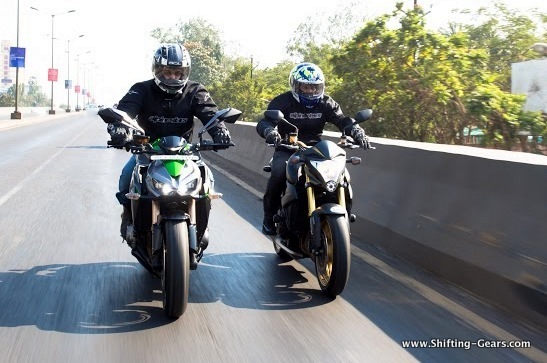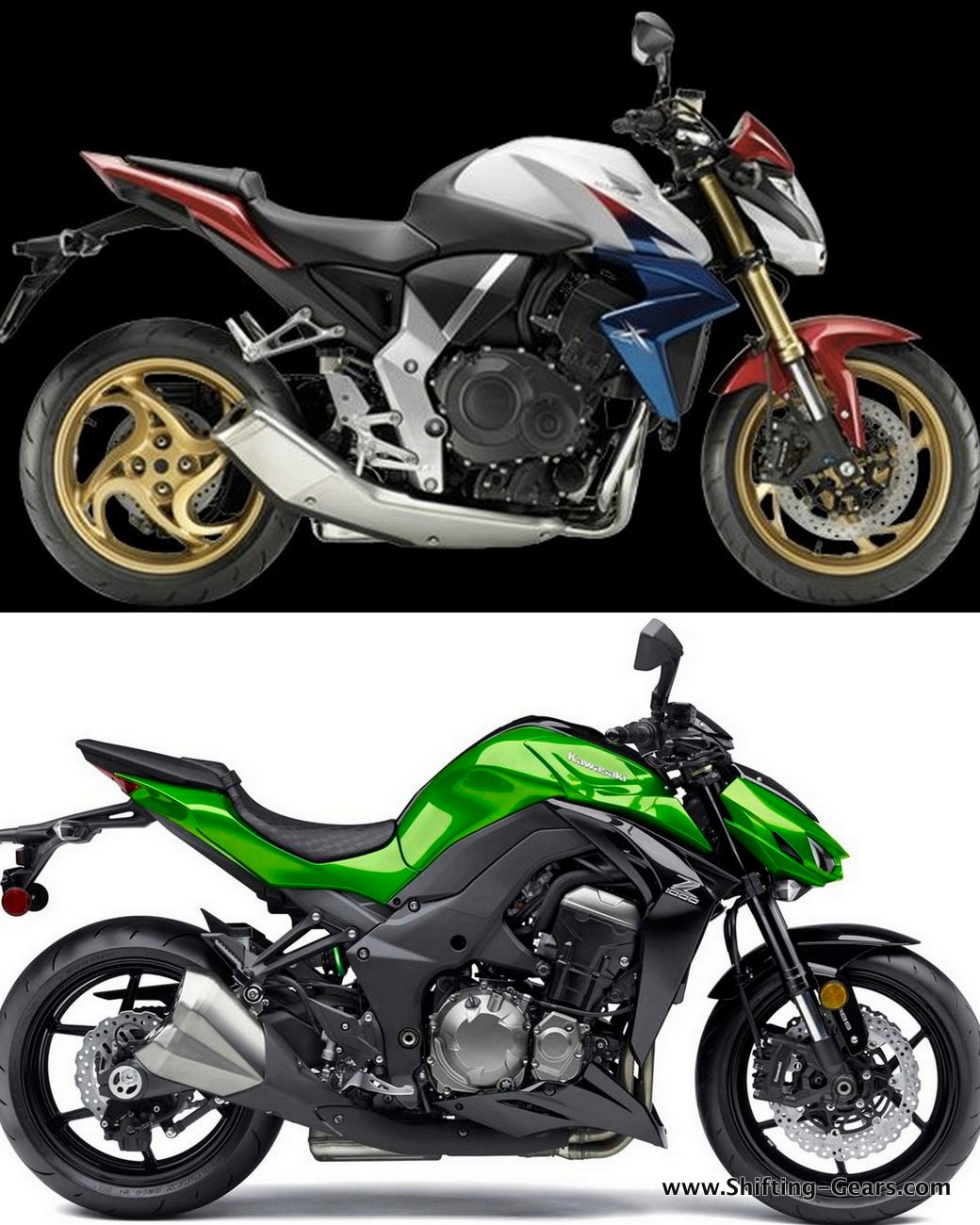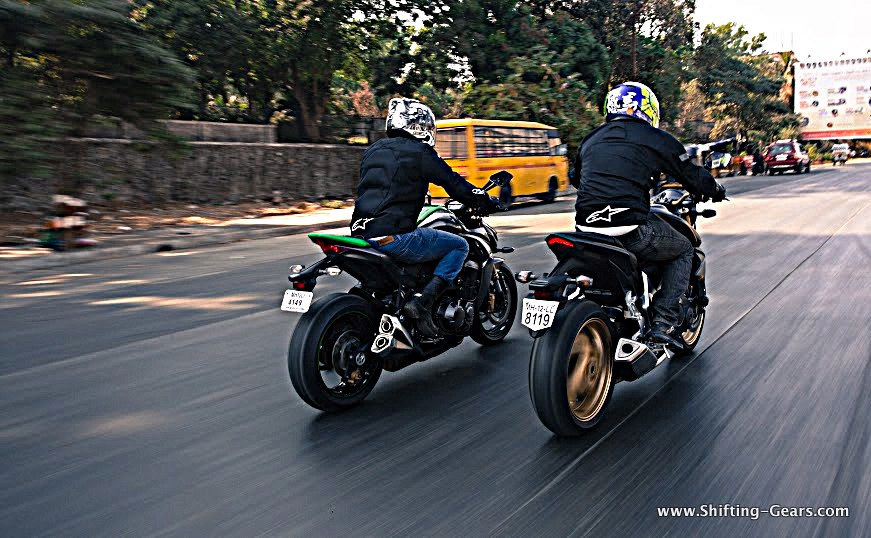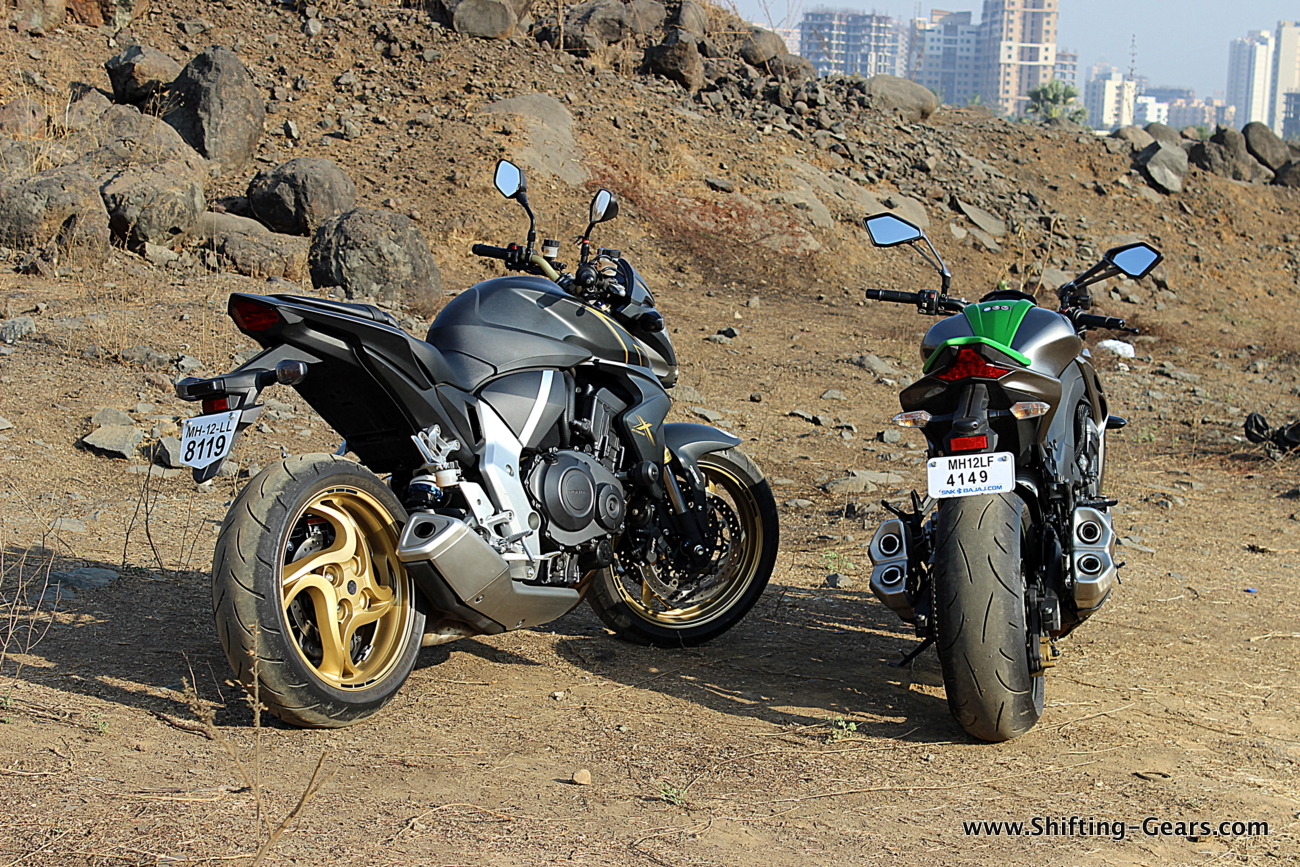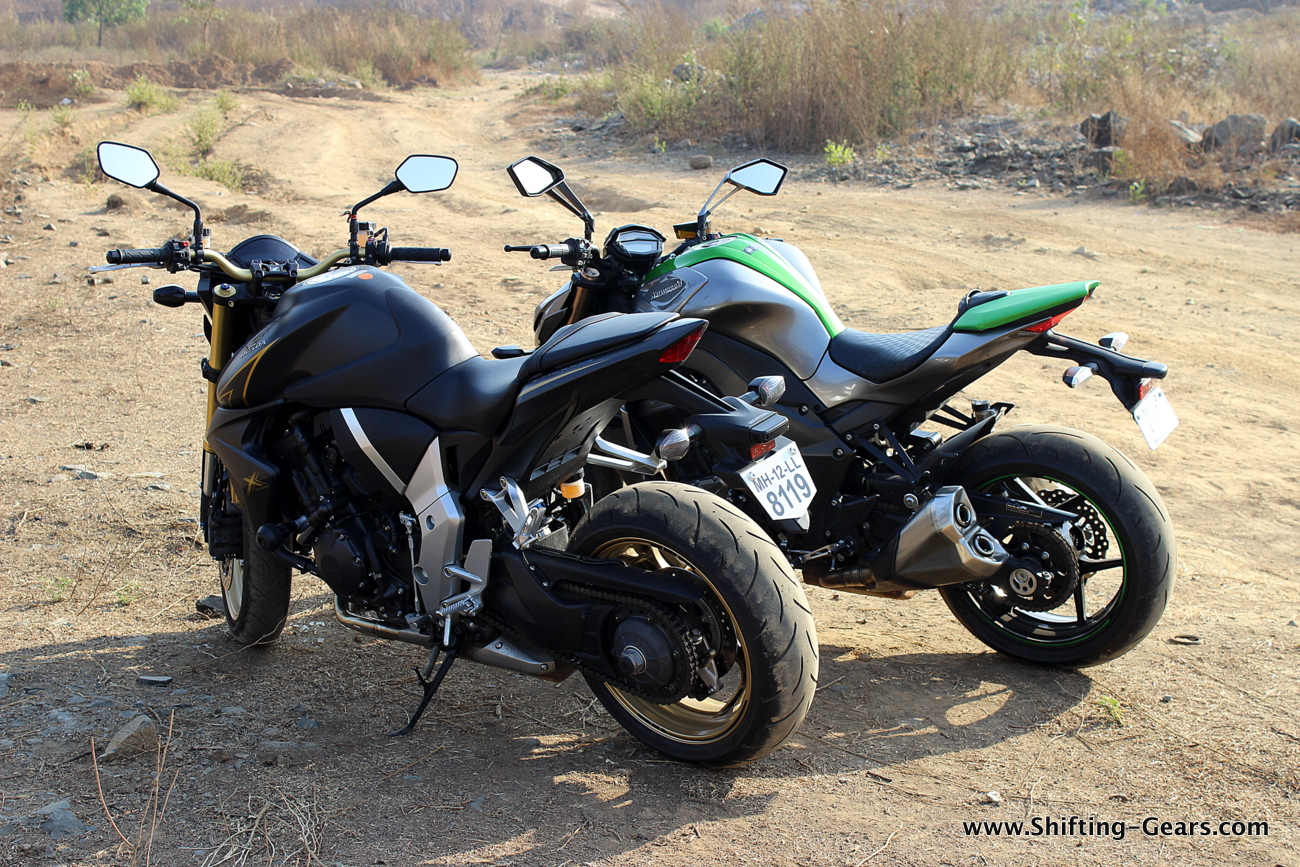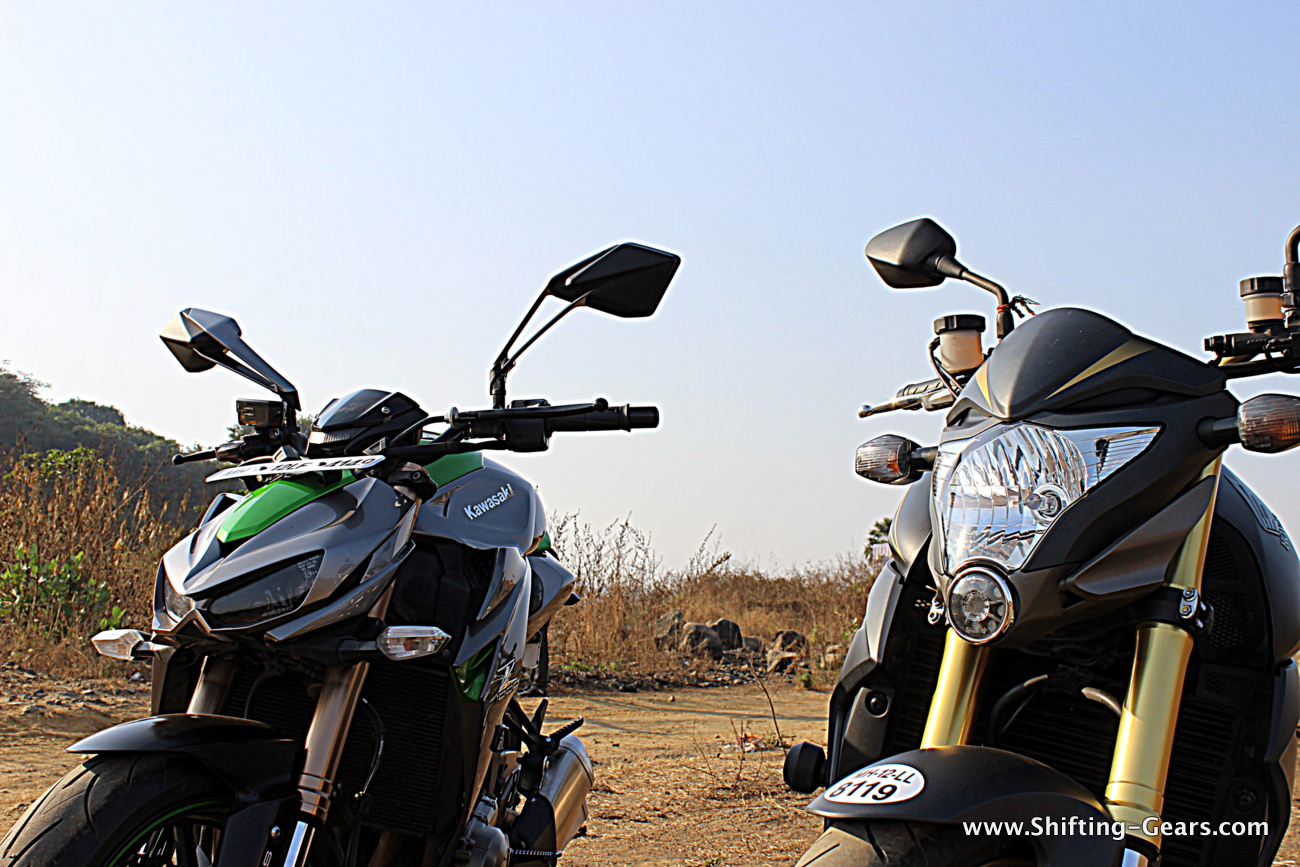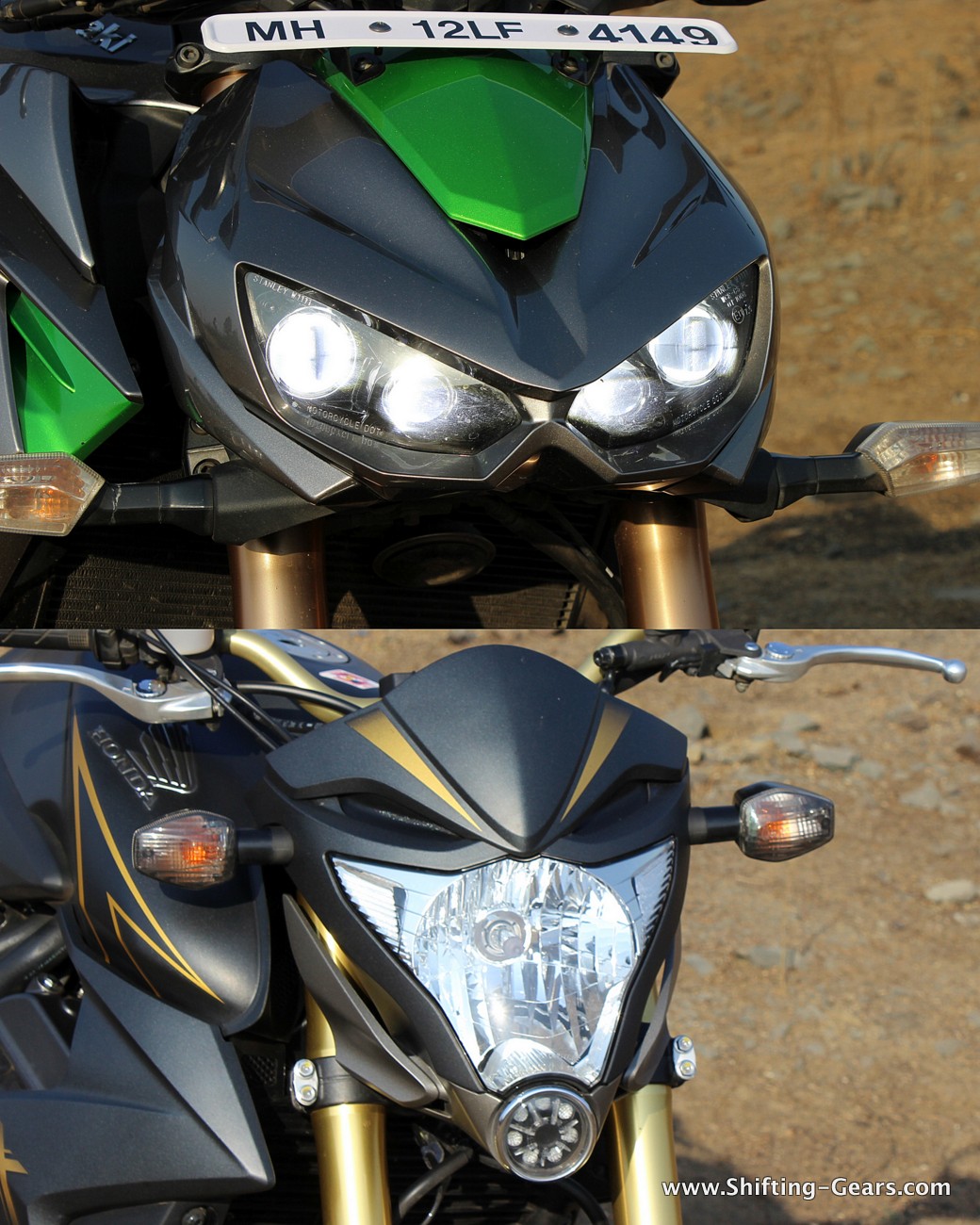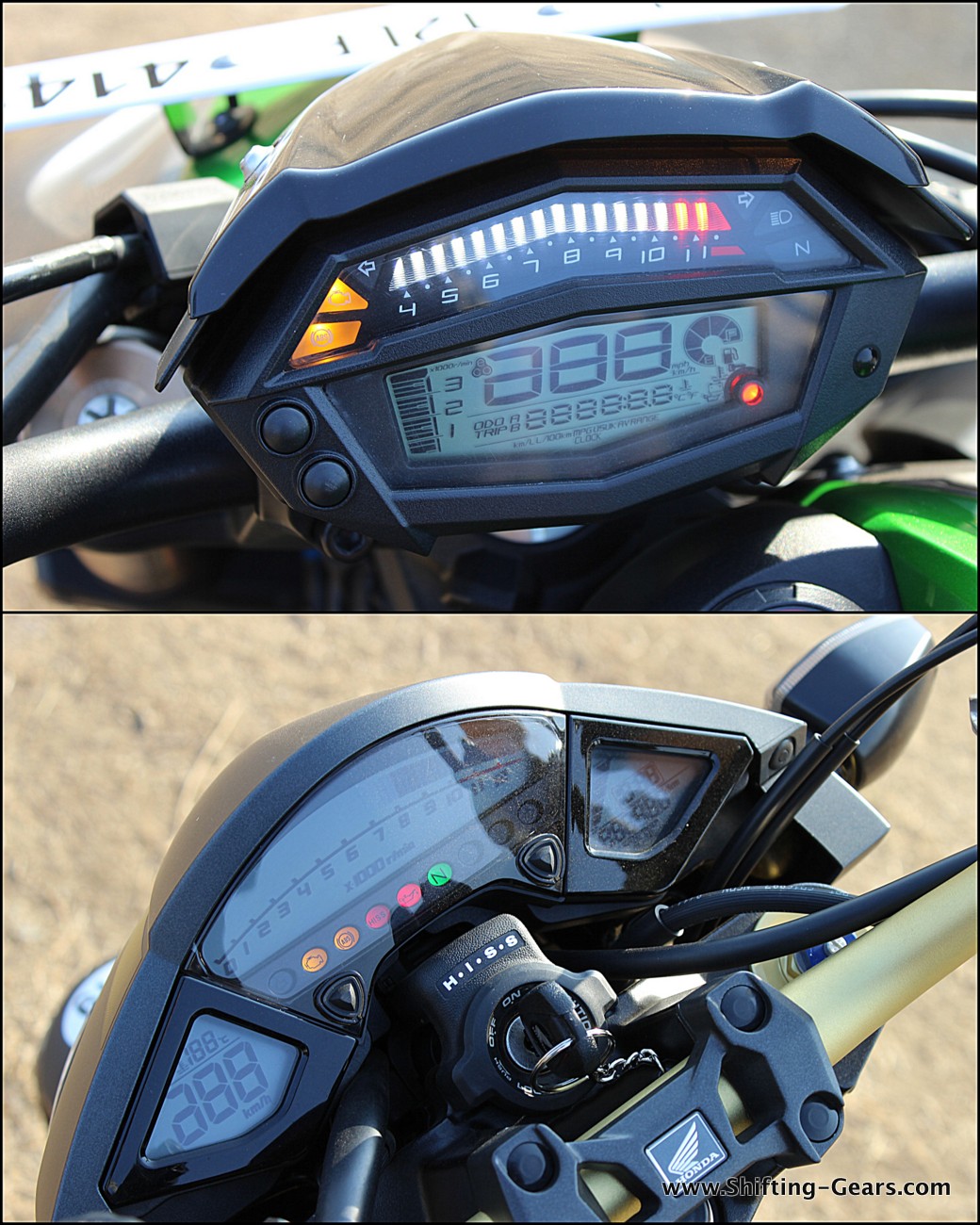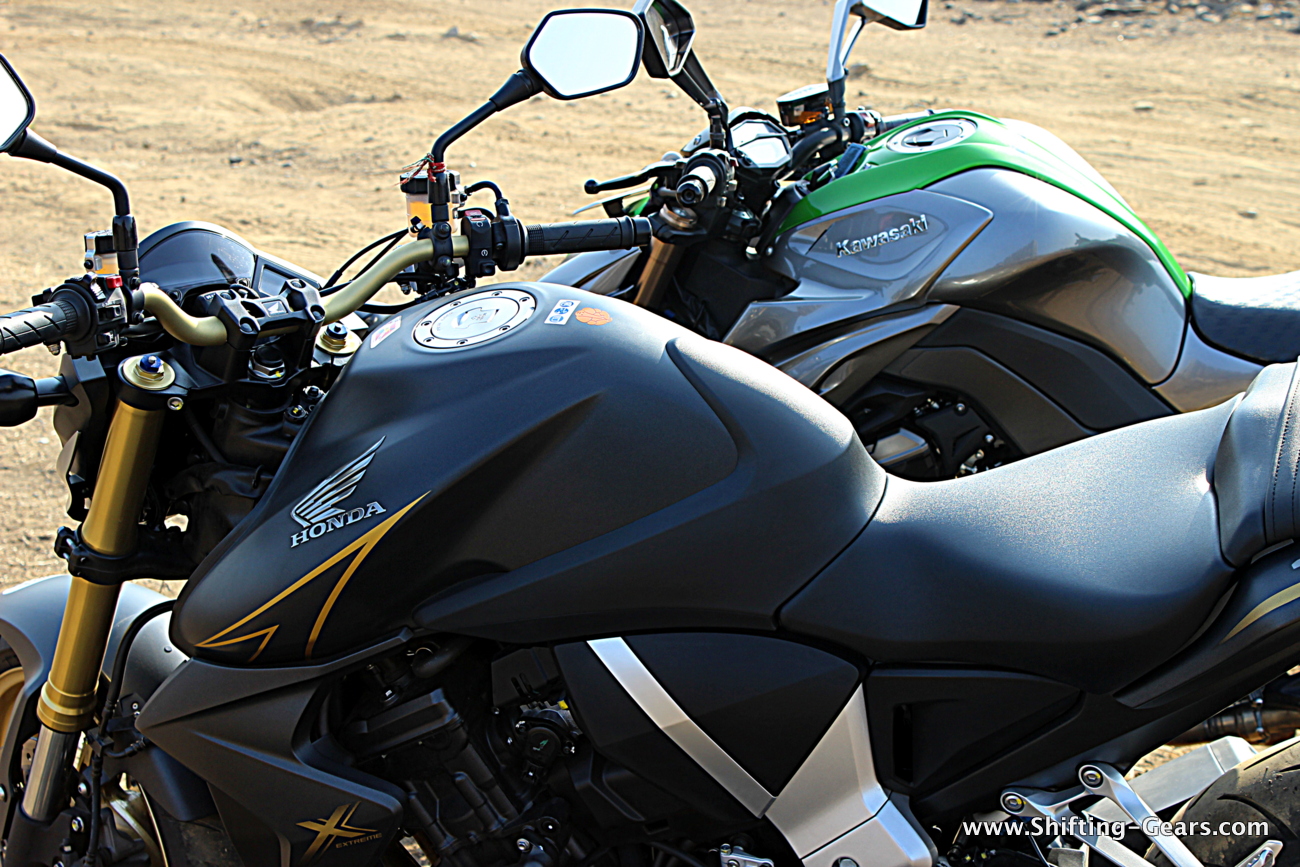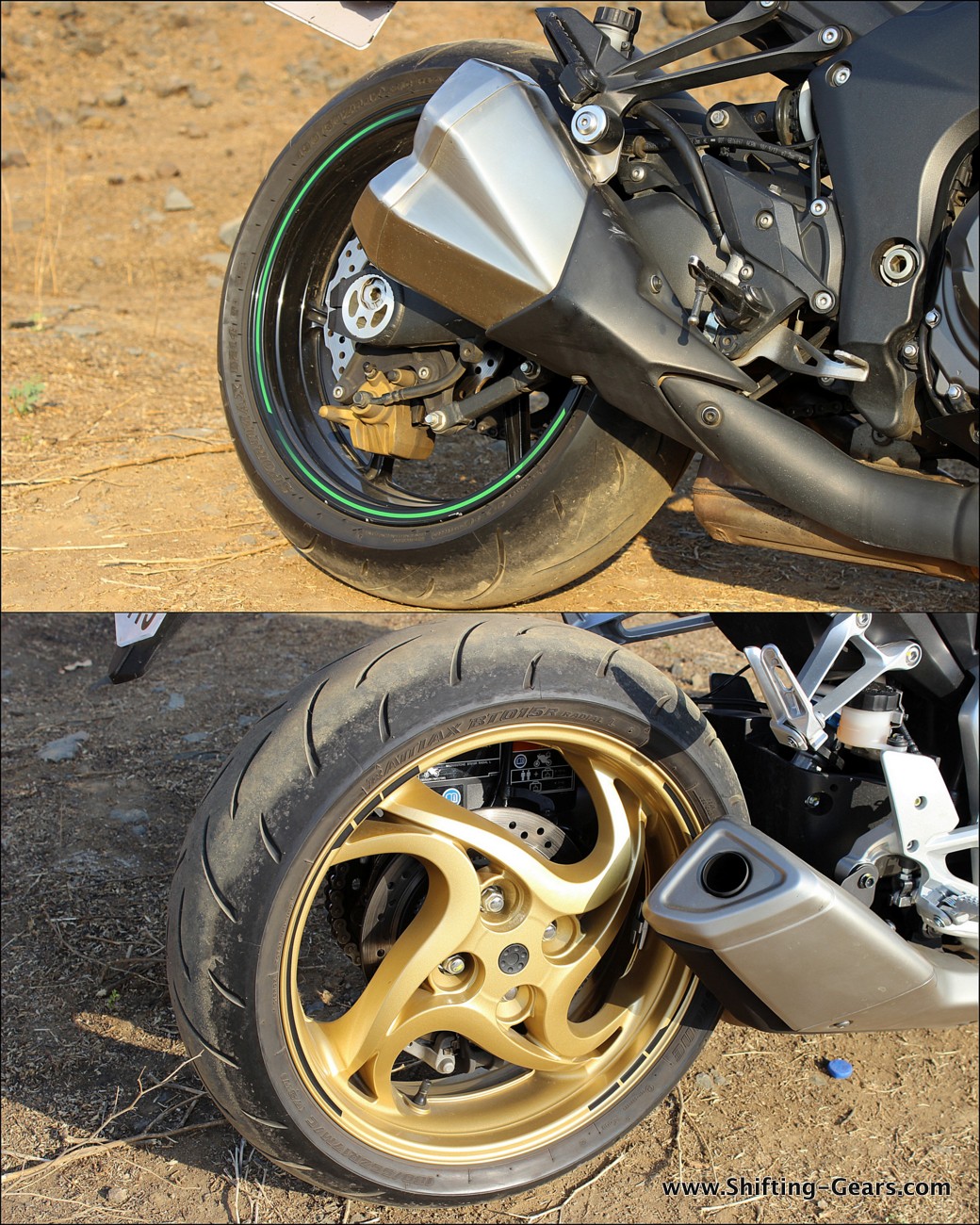If you’re in the market for a naked superbike, there aren’t many options in the litre-class. The options available include the outdated Yamaha FZ1, which is a rather forgotten motorcycle. The other three strong contenders are the Triumph Speed Triple, Honda CB1000R & the Kawasaki Z1000. The Triumph Speed Triple wasn’t available during the comparo, so we took both the Japanese litre-class supernakeds out for a spin to find out which among the two is more fun when you wring the throttle.
Both these bikes, the Honda CB1000R & the Kawasaki Z1000 are available for a brand new purchase in India. However, the used bike market is also flooded with good options. Both these bikes have a decent resale and serve as a good step up from a 600cc motorcycle or the likes. So if you’re confused between these two bikes, we’ll help you understand which might suit your taste better.
Price:
- Honda CB1000R ABS – Rs. 14.13 lakh (On-road Mumbai)
- Kawasaki Z1000: Rs. 14.57 lakh (On-road Mumbai)
For almost Rs. 40,000 more, the Kawasaki Z1000 is a more recent launch compared to the Honda CB1000R.
Styling:
For bikes costing upwards of one million rupees, there is no doubt that looks matter. Although a subjective department, we are sure that everyone will agree that the Kawasaki Z1000 looks absolutely smashing in the segment. However, although a bit old, the Honda CB1000R also managed to hold its ground well. It’s for two types of customers; those who prefer form over function and those who prefer function over form.
Both bikes get a small bikini fairing around the headlamp. Falling in the naked superbike category, there is nothing much in terms on body panels over here. The Z1000 makes the most out of a headlamp design. It looks striking, whether you look at it directly, or in your rear view mirror. The 4 projector lamps and the low front gives it a very predator like look. Although not as striking, the CB1000R with its Transformer-like headlamp design keeps up with today’s standards. It gets a round LED DRL setup on the chin and a regular halogen bulb on top. From the front, thanks to the flat headlamp layout, the Z1000 looks wider than the CB1000R.
From the side, aesthetics & body panels aside, both the bikes have one thing in common – a tightly packaged engine bay. Both the bikes hold on to their engines neatly while on the Kawasaki, the engine casing (on the side) does protrude a little making it prone to damage in case the bike takes a fall. Crash guards are a must have on these naked mile munchers. The Sugomi design as Kawasaki likes to call it; with a lowered front and raised back looks absolutely fantastic. The Z1000 can put almost every other motorcycle in the segment to shame with the design details. The headlamp sits low, the tank bulges out to give a big bike look in the centre and the rear tapers nicely. On the CB1000R, the headlamp & tank are positioned at almost the same height. The tank gets a very thoughtful black plastic cladding which acts as a tank protector. Both bikes have rear-set foot pegs & split + step-up seats. On the Z1000, the pillion seat used to be seen in green, while the 2015 models will be all-black. The rider seat on the Z1000 also had ‘Z’ pasted all over. The CB1000 on the other hand plays it conventional, with no so much dramatisation.
At the back, each bike has a cool thing. The Z1000 has an exhaust on either side, with two outlets in each end-can. The CB1000R has just a single, upswept exhaust pipe on the RHS. What’s cool on the Honda is the single-sided swingarm which looks fabulous. The exhaust very smartly ends well behind the rear-wheel hub to show off the single sided mounting. Both bikes get LED tail lamp setup and a long number plate mount.
If we have to give points on the styling department, the Kawasaki Z1000 scores a top 10/10 while the Honda CB1000R scores a very respectable 8.5/10 even though it is an older design.
Instrumentation & ergonomics:
Both the bikes get an all-digital instrument cluster. The instrument cluster on the Z1000 tries too hard to look cool though. RPM count from 1,000 – 3,000 is seen next to the speedometer while the rest all the way up to the redline is marked as horizontally placed digital bars on top. Backlit in white, although futuristic, the Z1000’s instrument cluster is just about average. If you ask us, the unit on the Z800 is much better to look at than this. On the CB1000R, you get a 3-pot layout. Speedo on the left, tachometer in the centre & other digital data on the right. Backlit in blue, the CB1000R’s console is much easier on the eyes while riding at night. The brightness level is just right.
Plastic quality has been a big let down on Honda’s and it is the same with the CB1000R as well. The switch gear looks like it has been lifted from a Splendor. Plastic quality is sub par and touch and feel is nothing great either. On the Z1000, plastics used are much better than the CB1000R for the switchgear. Rear view mirrors on the Honda are conventional units; while on the Z1000, you get a fixed stalk & head (cast alloy) and the mirror inside can be moved to your desired angle.
Seats on both the bikes are fairly accommodating. Seat compound is almost the same on both the bikes. The Z1000 has a seat height of 815m while the CB1000R is a bit taller at 825mm. Riders above 5’7” will have no problem getting used to either of these bikes. For the pillion, both bikes offer similar room, the CB1000R has marginally more space though & is flatter too.
Riding posture on the Z1000 is a bit more committed compared to the CB1000R. Both bikes have a forward biased stance giving you a nice & sporty feel while on the go. If you’re looking at attacking corners, the Z1000 will have an edge while if you want to tour for longer, the CB1000R is a better pick.
Engine, performance & handling:
In terms of outright displacement, the Kawasaki Z1000 has slightly more. The Kawasaki is powered by a 1,043cc, in-line 4-cylinder, 4-stroke, liquid-cooled petrol motor producing 142 PS of power @ 10,000 RPM & 111 Nm of torque @ 7,300 RPM matched to a 6-speed gearbox. The bike weighs 221 kg.
The Honda CB1000R is powered by a 998cc, in-line 4-cylinder, 4-stroke, liquid-cooled petrol motor producing 125 PS of power @ 10,000 RPM & 100 Nm of torque @ 8,000 RPM matched to a 6-speed gearbox. The bike weighs 217 kg.
The above engine specs suggest that the Kawasaki Z1000 clearly has an edge over the Honda CB1000R when it comes to power and torque figures. Power to weight ratio of the Z1000 is 643 PS / tonne while that of the CB1000R is 576 PS / tonne. Clearly, the Kawasaki is a stronger performer.
While riding, the Kawasaki is very explosive if you wring the throttle. The bike builds up revvs very fast and accelerates to its top speed well over 200 kmph very quickly. However, it doesn’t loose too much traction while doing so. Power delivery is linear, and the bike keeps sprinting all the way up to the redline. On the CB1000R however, the power is put down not as well as on the Kwacker. The rear looses traction at times and this can catch you mid-corner if you open up the throttle too much.
Both bikes although built to do high-speed runs, are fairly easy to ride in the city. In top gear, both the bikes can be used around the 60 kmph mark without any hesitation from the engine. Heat management however is better on the Kawasaki again. In stop and go traffic, we could notice the radiator coming into play on the Honda, while the Kawasaki took the beating for a bit longer.
On the highway, both bikes are quick. Yes, the extra horses on the Z1000 surely provide more punch than the CB1000R does. Not just that, on the highways, the exhaust note on the Z1000 is much, much better than the Honda. Another reason for that is the design of the airbox on the Kawasaki which lets out a sweet intake howl.
Riding on bad patches, you need to be double cautious on the Honda. The CB1000R has a better ground clearance of 130mm compared to 125mm on the Z1000, but the Honda scraped on a couple of speed breakers while the Kawasaki tackled them neatly.
Suspension setup on both the bikes is performance biased, which is stiff. The Z1000 is stiffer among the two bikes. This gives it very good handling abilities when in your favourite twisties. However, the CB1000R makes riding more comfortable with a marginally better ride quality. If you ride both the bikes for long, the CB1000R will result in a little less fatigue. High speed stability on both bikes is almost equal. Wind deflection is a little better on the Z1000 though, thanks to the edgy design.
Braking performance, thanks to ABS is good on both the bikes. On the Kawasaki, the brake bite for the rear is a bit slow but on the Honda, it is fairly sharp. Both bikes handle panic situations well and the bikes stop in a straight line without fishtailing. While the ABS did kick in on the Z1000, the C-ABS on the Honda works like a dream. The brakes are confidence inspiring and one can attack corners without second thoughts. Another mention goes to the sticky rubbers both bikes come equipped with.
So if you’re in the market to buy a bike between these two, we must mention, it is a close fight. It all comes down to what you prefer. The CB1000R looks more mature, and still manages to hold on its ground in today’s date. The Kawasaki Z1000 on the other hand is radical to look at, and ride as well. If you don’t want too much attention on the roads, and prefer a good litre-class sportsbike which can allow you to tour, the CB1000R could tick all your boxes. But if you want a snazzy looking, head-turner; there is no doubt that the Kawasaki Z1000 is one of the best looking superbikes on sale in India.
If you’re buying a new unit, we recommend the Kawasaki Z1000. If you’re in the used bike market, there will be some good deals on the Honda as well. However, do note, older Honda CB1000R’s did not come with ABS.
Image credits: Vipul Prasad

